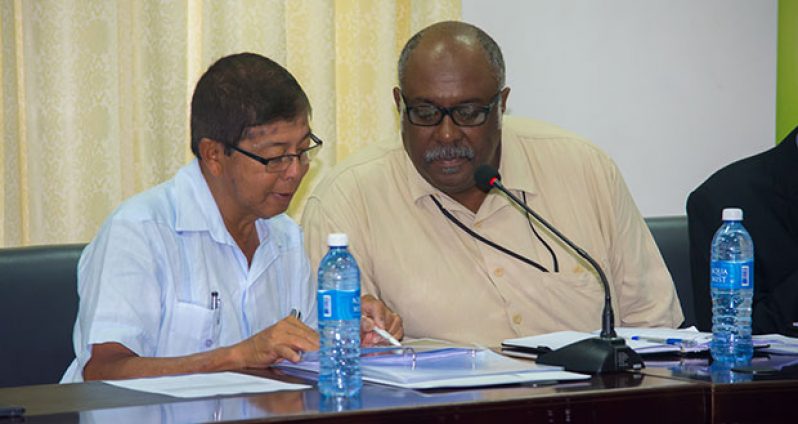By Svetlana Marshall
WITH all hands on deck, the safety issues plaguing the mining sector could be resolved, Natural Resources Minister Raphael Trotman said as he called for a collaborative approach to reduce the risks attached to mining, particularly in the gold-mining industry. According to statistical reports, from 2010 to 2015 a total of 62 miners were killed while working in the mining sector. Of that batch, 31 were killed over the past two years due to the collapse of mining pits.
What is needed is “a road map,” Minister Trotman said as he addressed active players in the field during a Mining Safety Seminar at the Arthur Chung Convention Centre on Wednesday.
In keeping with the theme: “Putting Safety First in Mining – charting a course to cultivate compliance and strengthening enforcement,” he said governmental action is necessary to lead the way as the key regulator of the industry, but the government alone cannot do it.
A collective role must be recognised, accepted, and immediately implemented, the Natural Resources Minister emphasised, noting that business can no longer continue as usual unless the systems for operating, monitoring and modernizing the mining sector are revisited.
“It must, by necessity, include a refined Government policy, enhanced regulation, monitoring and enforcement by the Guyana Geology and Mines Commission (GGMC), and improved education techniques supported by our technical institutes, university, and by the companies that profit from the sale of excavators, ATVs and mining equipment,” he explained.
“In short, it is in all of our interest to join hands to tackle this scourge,” Minister Trotman added.
With this in mind, the seminar, facilitated by the Natural Resources Ministry, was designed to put on focus modern mechanisms, innovative and time-tested ways that can improve the health and safety practices within the sector.
Additionally, it set the stage for the development, documentation and launch of an Action Plan, to mitigate the risks of fatal accidents in the mining industry.
While it is critical to educate miners at this stage, given the alarming numbers of accidents in the sector which have led to injuries and even deaths, Minister Trotman believes that introspection must first be done at the level of the regulatory bodies, hence the seminar targeted active players from the GGMC, including the mines officers and representatives from the Guyana Mining School and Training Centre.
“We must…be up to date with the best practices that exist, areas of contextual relevance and the most effective means of communicating the essential messages,” Minister Trotman posited, while stating that the seminar creates a platform for stakeholders to initiate a plan that would be comprehensive and transformative.
Already,the GGMC, in collaboration with the Mining , has developed a module for general managers of dredge operations and persons entering mining with the intention of providing mandatory training in the various processes of mining – from financial management to mine pit design, construction and maintenance, and basic first aid techniques. The module was completed this year.
“The small and medium-scale miners are faced with several challenges. These include knowing where to position their dredge to make a profit and how to effectively come into compliance with the regulations and laws that the mining sector demands. The Ministry of Natural Resources, together with the GGMC and the Mining School aims to assist them to achieve their aims,” Minister Trotman emphasised.
According to him, since taking office, the coalition government has been building the capacity of workers in the sector to respond to the challenges in the sector.
It was pointed out that last January, the ministry with support from the Inter-American Development Bank (IDB) facilitated a Training of Trainers Programme which sought to enhance the capacity of GGMC’s workers in the area of safety. That was followed by a Caribbean Regional Training Workshop on Environment, Community, Health and Safety in the Neglected Development Minerals sector in April – the month designated for the promotion of Occupational Health and Safety. That seminar had received the backing of the United Nations Development Programme (UNDP).
“It is anticipated that these capacity-building opportunities that were provided will be useful in the successful execution of today’s main objective to create a roadmap to address mining safety and to arrest the deaths in this industry that we all hold dear. Safe, and productive mining is in the best interest of Guyana and every Guyanese,” Minister Trotman said. Paraphrasing a popular slogan, he said “All lives matter, miners’ lives matter.”
Major-General Ret’d Joseph Singh, who was among key speakers at the forum, in his address alluded to the 2015 Commission of Inquiry (CoI) which was conducted by Dr. Grantley Walrond. At the end of that inquiry, Dr. Walrond had concluded the the principal cause of pit- failure accidents was the constant neglect of safe mining practices.
Major-General Singh, who had also conducted two CoIs in 2016, had made a similar conclusion. In a series of recommendations, he called on the GGMC to take stern action against defaulters within the industry.
“Mining property owners must be held accountable by GGMC for all mining operations within the boundaries of their properties, their compliance with the Mining Act and Regulations, and their ability to manage mining operations using the best possible technical, health and safety and environmental practices,” he said.
GGMC, he said, must also ensure that its mines officers are adequately equipped to execute their duties, while noting that property owners are accountable to the commission. The key players at the ground level, ranging from the property owners, dredge owners, general managers to rangers must mine in a responsible manner, in keeping with the legislations and regulations in place.
Craig Timms of Troy Resources Guyana Inc, and Charles Ceres and Michael Williams of Guyana Goldfields had also delivered in-depth presentations on recommended best practices for safety in mining and for open-pit mine construction. Dr. Walrond had also made a case for change, as he gave an in-depth analysis on the current status of the sector with respect to safety.



.jpg)









